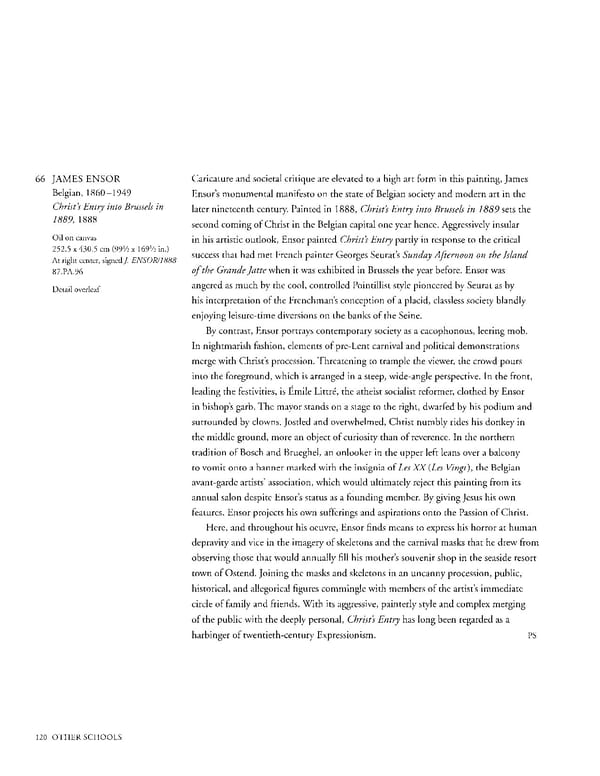66 JAMES ENSOR Caricature and societal critique are elevated to a high art form in this painting, James Belgian, 18601949 Ensor's monumental manifesto on the state of Belgian society and modern art in the Christ's Entry into Brussels in later nineteenth century. Painted in 1888, Christ's Entry into Brussels in 1889 sets the 1889, 1888 second coming of Christ in the Belgian capital one year hence. Aggressively insular Oil on canvas in his artistic outlook, Ensor painted Christ's Entry partly in response to the critical 252.5 x 430.5 cm (99½ x I69½ in.) success that had met French painter Georges Seurat's Sunday Afternoon on the Island At right center, signed J. ENSOR/1888 87.PA.96 of the Grande Jatte when it was exhibited in Brussels the year before. Ensor was Detail overleaf angered as much by the cool, controlled Pointillist style pioneered by Seurat as by his interpretation of the Frenchman's conception of a placid, classless society blandly enjoying leisuretime diversions on the banks of the Seine. By contrast, Ensor portrays contemporary society as a cacophonous, leering mob. In nightmarish fashion, elements of preLent carnival and political demonstrations merge with Christ's procession. Threatening to trample the viewer, the crowd pours into the foreground, which is arranged in a steep, wideangle perspective. In the front, leading the festivities, is Emile Littre, the atheist socialist reformer, clothed by Ensor in bishop's garb. The mayor stands on a stage to the right, dwarfed by his podium and surrounded by clowns. Jostled and overwhelmed, Christ numbly rides his donkey in the middle ground, more an object of curiosity than of reverence. In the northern tradition of Bosch and Brueghel, an onlooker in the upper left leans over a balcony to vomit onto a banner marked with the insignia of Les XX (Les Vingt), the Belgian avantgarde artists' association, which would ultimately reject this painting from its annual salon despite Ensor's status as a founding member. By giving Jesus his own features, Ensor projects his own sufferings and aspirations onto the Passion of Christ. Here, and throughout his oeuvre, Ensor finds means to express his horror at human depravity and vice in the imagery of skeletons and the carnival masks that he drew from observing those that would annually fill his mother's souvenir shop in the seaside resort town of Ostend. Joining the masks and skeletons in an uncanny procession, public, historical, and allegorical figures commingle with members of the artist's immediate circle of family and friends. With its aggressive, painterly style and complex merging of the public with the deeply personal, Christ's Entry has long been regarded as a harbinger of twentiethcentury Expressionism. PS 120 OTHER SCHOOLS
 Masterpieces of the Getty Museum: Paintings Page 120 Page 122
Masterpieces of the Getty Museum: Paintings Page 120 Page 122